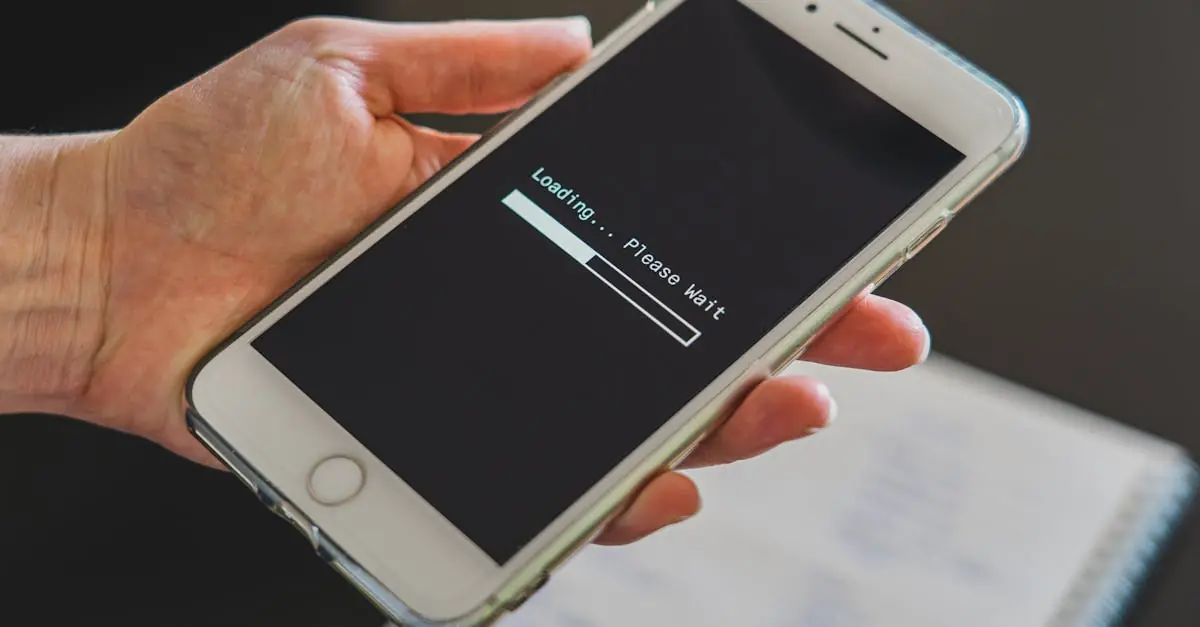Ever found yourself in a battle with technology, staring at your Alexa like it’s a Rubik’s Cube? Connecting her to Wi-Fi without the app on your iPhone might seem like an impossible quest, but fear not! With a sprinkle of tech magic and a dash of patience, you can turn that perplexing puzzle into a smooth symphony of smart home bliss.
Table of Contents
ToggleUnderstanding Alexa Setup
Connecting an Alexa device to Wi-Fi without the app involves a few straightforward steps. Users must first ensure they have access to the device’s built-in setup mode. The device typically enters this mode automatically during the initial setup process, which can be activated by plugging it in and waiting for the light ring to turn orange.
In order to connect, it’s crucial to have the right Wi-Fi credentials on hand. The Wi-Fi network name and password serve as key components for establishing the connection. It’s wise to double-check this information to prevent issues during the setup.
Next, individuals can use a computer or another smartphone with a web browser. Typing the Alexa device’s temporary Wi-Fi network into the browser’s address bar leads to the setup page. This step allows users to enter their Wi-Fi credentials directly.
Once the credentials have been inputted, the device attempts to connect to the specified network. Observing the light ring can help confirm the connection status; it should turn blue if successful. If the connection fails, troubleshooting steps may include restarting the device or rechecking network information.
After the device connects, users can begin using Alexa’s features. Utilizing voice commands becomes seamless as the smart home experience unfolds. Ensuring that the device remains within range of the Wi-Fi router can help maintain a stable connection.
Following these steps enables a smooth transition into the world of smart home technology. Simplifying the process fosters confidence, making smart home integration accessible for all.
Prerequisites for Connecting Alexa
Before connecting the Alexa device to Wi-Fi, gather the necessary elements. These include ensuring the device is compatible and ready for setup.
Device Requirements
An Alexa device must be in setup mode, which appears as an orange light ring. The device should also support Wi-Fi connectivity, whether it is Echo, Echo Dot, or another model. A power source is essential for operation, so plug it into an outlet. Users must ensure the device is nearby the Wi-Fi router during setup for optimal signal strength.
Network Considerations
Wi-Fi network requirements play a crucial role in the connection process. A working Wi-Fi network with a minimum speed of 1 Mbps ensures smooth operations. Always have the network name (SSID) and password ready for input during the setup. The router should support 2.4 GHz or 5 GHz bands, but compatibility with both is recommended. Ensure the network is visible and not hidden, as this simplifies the connection.
Step-by-Step Guide for Connecting Alexa
Connecting an Alexa device to Wi-Fi without using the app on an iPhone requires specific steps. Following these instructions helps users set up their devices with ease.
Using Voice Commands
Users can initiate the setup process directly through voice commands. Starting by saying, “Alexa, turn on setup mode” prompts the device to enter this mode. The orange light ring confirms that the device is ready for configuration. Once the light appears, the user can say, “Help me connect to Wi-Fi.” This method simplifies the process and avoids the need for the app. Users should clearly state their Wi-Fi network name and password when prompted for the information, ensuring accuracy.
Using the Alexa Device
Accessing the Alexa device settings becomes easier without the app. First, users must power on the device and ensure it is close to the router. After the orange light indicates setup mode, connecting to the temporary Wi-Fi network opens a web browser on a computer or another smartphone. Entering the device’s IP address leads to a configuration page where users input their Wi-Fi credentials. Once submitted, a successful connection triggers a blue light. In case of failure, users can retry by checking their entered information or restarting the device.
Troubleshooting Common Issues
Connection issues can arise despite following the correct steps. Restarting the Alexa device often resolves many problems. Power cycling the Wi-Fi router can also help restore a strong connection.
Checking that the device is in setup mode is crucial. An orange light ring signals that it is ready for configuration. If the device does not display this light, pressing the action button can reinitiate the setup mode.
Incorrect Wi-Fi credentials may cause connection failures. Double-checking the network name and password helps ensure they are entered correctly. Maintaining attention to uppercase and lowercase letters is necessary, as Wi-Fi credentials are case-sensitive.
Network visibility plays a significant role in successful connections. Ensure the Wi-Fi network is not hidden, as hidden networks complicate setup. Running a speed test can confirm that the Wi-Fi network meets the minimum requirement of 1 Mbps.
Obstructions between the device and the router can weaken signals. Placing the device closer to the router often enhances connectivity. Removing physical barriers such as walls or furniture can also boost the signal strength.
Using a different browser might alleviate web-based setup issues. Some users experience compatibility problems with certain browsers. Switching to a more standard browser like Chrome or Firefox can provide a smoother setup process.
Additional support may be necessary if problems persist. Consulting the Alexa support page offers a wealth of troubleshooting resources. Failing all else, contacting customer service can provide personalized assistance in resolving connection issues.
Connecting Alexa to Wi-Fi without using the app on an iPhone might seem daunting but it’s entirely manageable with the right approach. By following the outlined steps and ensuring all prerequisites are met, users can streamline the setup process.
Patience is key; if initial attempts don’t succeed, troubleshooting can often resolve connectivity issues. With the device successfully connected, users can fully enjoy the convenience and capabilities of their smart home. This alternative method not only simplifies the process but also empowers users to take control of their Alexa experience.



